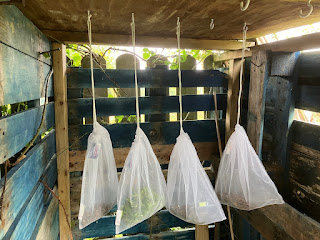Monkshood / Wolfsbane
USUAL WARNING: DON’T TRY THIS AT HOME, OR ANYWHERE ELSE. THESE ARE NOT RECREATIONAL DRUGS, THESE ARE TOXIC PLANTS FOR EMERGENCY USE ONLY AND NEED TO BE TREATED WITH THE UTMOST REPECT.
This month we are returning to our core theme of toxic plants. Regular readers will remember that that the purpose of this blog is to explore the medicinal uses of certain toxic herbs, sometimes known as “witches’ herbs”, with particular reference to their potential use as anaesthetics, in the event that chemically based anaesthetics become unavailable or in short supply - as was the case, for example, during World Wars 1 and 2 when Britain was subject to a German U-boat blockade.
So today we are looking at monkshood, also known as aconite or wolfsbane, latin name Aconitum napellus. The plant is so named because the flowers look a little like a medieval monk’s hood, and because extracts of the plant were used to prepare poisoned arrows for hunting wild animals.
 |
| Monkshood flower |
Monkshood is a common garden plant and here’s what some people say about it. Alan Titchmarsh, everyone’s favourite TV gardener, describes it as “extremely poisonous” and advises not to grow it in a garden where there may be small children. The Royal Horticultural Society sells it from its plant shop but warns: “TOXIC if eaten, avoid skin contact. Wear gloves and other protective equipment when handling.” The US National Capital Poison Centre says “swallowing any part of the plant could be deadly”.
All of these are true, of course - if you take too high a dose. Monkshood contains several toxic compounds, most notably aconitine which is a neurotoxin; it blocks nerve conduction which in severe cases can result in paralysis of the breathing muscles, abnormalities of heart rate and rhythm, and death.
However, the effects are dose related, and in small doses it shows potential for use as a local anaesthetic.
 |
| Monkshood leaf |
I tried chewing a 1cm square piece of fresh monkshood leaf for 30 seconds then spitting it out (not swallowing it). I noticed a numb sensation in my mouth and throat, similar to a dental anaesthetic, which reached its peak after half an hour and had almost gone after two hours. There were no other effects.
The photo at the top of this page shows monkshood plants growing on my allotment. There are several varieties of monkshood which may have slightly different shaped leaves.
Monkshood grows during the summer, so if you want a supply for year round use, you will need to dry it. On my allotment there is an old rickety shed with no door, made out of pallets by the previous occupant. It is useless for storing garden tools, but perfect for drying herbs.
This is the shed from the outside:
 |
| Herb drying shed |
And this is the inside of the shed, with herbs hanging to dry in fine mesh bags. It is important to have a good flow of air to promote rapid drying without mould formation.
 |
| Herbs drying in mesh bags |
Here is the finished product in a jar:
 |
| Dried monkshood leaves in airtight jar |
Aconitine is barely soluble in water but is soluble in alcohol, or a mixture of alcohol and water. So if you need to reconstitute the dried monkshood, it would be best to stand the leaves in a spirit such as white rum or vodka for a day or two, then strain it to remove the vegetable material.
It is best to use young leaves because they contain more aconitine. Old leaves will dry to a brown colour. Young leaves should remain green when dry.
Slaynt vie, bea veayn, beeal fliugh as baase ayns Mannin


.jpg)

You probably learnt aboutHanaoka Seishū ? I am also working on if its possible with pharmaceuticals from biogass. https://esaic.org/the-japanese-surgeon-who-performed-general-anaesthesia-decades-before-morton/
ReplyDelete